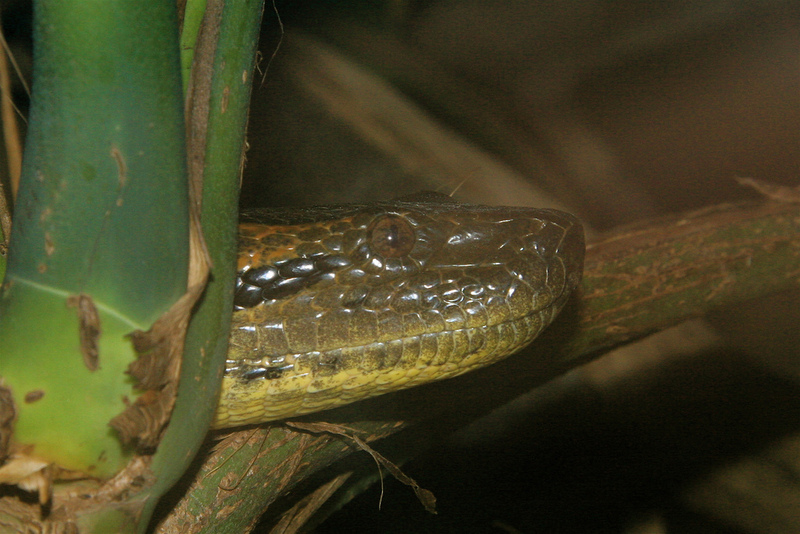|
Anaconda (Genus: Eunectes) - Wiki
| 제목: | Anaconda (Genus: Eunectes) - Wiki
| |

| 해상도: 1024x683
파일크기: 364677 Bytes
등록시간: 2008:01:14 11:17:06
|
Anaconda
From Wikipedia, the free encyclopedia
Order: Squamata
Suborder: Serpentes
Family: Boidae
Subfamily: Boinae
Genus: Eunectes Wagler, 1830
[Photo] Green Anaconda (Eunectes murinus). "Depending on the criterion you use to judge largeness, this is one of the largest snakes in the world...well not this particular individual, but maybe some day." Taken at the San Diego Zoo, California. Source: Flickr (www.flickr.com/photos/alumroot/103671627/) Author: alumroot (www.flickr.com/photos/alumroot/).
Anacondas are four species of aquatic boa inhabiting the swamps and rivers of the dense forests of tropical South America. The Yellow Anaconda can be found as far south as northern Argentina.
Species
- Bolivian Anaconda, Eunectes beniensis
- Dark-spotted Anaconda (De Schaunensee's Anaconda), Eunectes deschauenseei
- Green Anaconda, Eunectes murinus
- Yellow Anaconda, Eunectes notaeus
Etymology
There are two possible origins for the word 'anaconda.' It is perhaps an alteration of the Sinhalese word henakandaya, meaning 'whip snake', or alternatively, the Tamil word anaikondran, which means 'elephant killer'. It is unclear how the name originated so far from the snake's native habitat; it is likely due to its vague similarity to the large Asian pythons. Local names for the anaconda in South America include the Spanish term matatoro, meaning 'bull killer', and the Native American terms sucuri and yakumama. Anacondas as members of the boa family are sometimes called water boas. The Latin name for Anaconda is Eunectes (from the Greek "Eυν??κτη??", meaning "good swimmer").
Size
There is some debate about the maximum size of anacondas, and there have been unverified claims of enormous snakes alleged to be as long as 30???45 m (98.4???147.6 ft). According to Lee Krystek, a 1944 petroleum expedition in Colombia claimed to have measured an 11.43 m (37.5 ft) specimen, but this claim is not regarded as reliable; perhaps a more credible report came from scientist Vincent Roth, who claimed to have shot and killed a 10.3 m (33.8 ft) specimen.
There are some reports from early European explorers of the South American jungles seeing giant anacondas up to 18.2 m (60 ft) long, and some of the native peoples have reported seeing anacondas up to 15.2 m (50 ft) long, but these reports remain unverified.
Another claim of an extraordinarily large anaconda was made by adventurer Percy Fawcett. During his 1906 expedition, Fawcett wrote that he had shot an anaconda that measured some 18.9 m (62 ft) from nose to tail. Once published, Fawcett’s account was widely ridiculed. Decades later, Belgian zoologist Bernard Heuvelmans came to Fawcett's defence, arguing that Fawcett's writing was generally honest and reliable.
Historian Mike Dash writes of claims of still larger anacondas, alleged to be as long as 30???45 m (100???150 ft) ??? some of the sightings supported with photos (although those photos lack scale). Dash notes that if a 50???60 ft anaconda strains credulity, then a 150 ft long specimen is generally regarded as an outright impossibility.
It should be noted that the Wildlife Conservation Society has, since the early 20th century, offered a large cash reward (currently worth US$50,000) for live delivery of any snake of 30 feet or more in length. The prize has never been claimed. Also, in a study of 1,000 wild anacondas in Brazil, the largest captured was 17 feet (5.2 m) long.
Recently an anaconda snake measuring over six meters and weighing nearly 200 kilos was captured in the backyard of an abandoned house in Parana, Brazil.
In captivity
There have been very few instances of anacondas being bred in captivity. In October 2007, the New England Aquarium in Boston achieved a breakthrough when it was discovered that one of the aquarium's female anacondas was gravid. On January 1st, 2008, fourteen anaconda babies were born at the New England Aquarium. Anacondas, like other boas, give birth to live young. Their colours are yellow and green.
http://en.wikipedia.org/wiki/Anaconda
| The text in this page is based on the copyrighted Wikipedia article shown in above URL. It is used under the GNU Free Documentation License. You may redistribute it, verbatim or modified, providing that you comply with the terms of the GFDL. |
|
댓글 |
|---|
| | 손님 |
|
Scientific Name: Eunectes murinus (Linnaeus, 1758)
Common Names: Anaconda, Green Anaconda, Water Boa, Große Anakonda [German]
Synonyms:
Boa aquatica Wiedneuwied, 1824
Boa gigas Latreille, 1802
Boa murina Linnaeus, 1758
Boa scytale Linnaeus, 1758
Eunectes barbouri Dunn & Conant, 1936
Eunectes gigas Beebe, 1946
Eunectes murinus gigas (Latreille In Buffon, 1801)
Eunectes murinus murinus Duellman, 1978 |
^o^
동물그림창고 똑똑전화 누리집
^o^
|
|
|